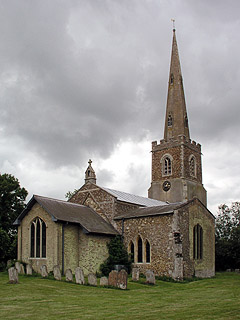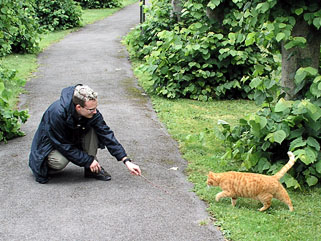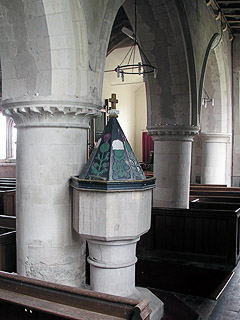It's rare for a parish church to have possessed the body of a saint - relics were generally snapped up by the richer monastic foundations. Here at Eltisley, then, the parish was fortunate to have the body of St Pandionia - and even if her burial place is no longer visible, her name survives in the unusual dedication. She was, according to legend, the daughter of a 10th century Scottish king.
As is often the case with female saints from the middle ages, her chaste virtue was threatened, but instead of growing a beard or turning her assailants into hogs, she fled here to Eltisley and joined a community of nuns. She adopted the religious life, and was buried next to a holy well. Eventually her body was exhumed and reburied inside the church in 1344.
The present church sits in a fine churchyard with some nice mature trees and (when we visited) a very friendly ginger cat, who came and demanded that we play with him before entering the church. We also took a moment to look at the wonderful spire, which rises to a great height from a surprisingly slender carstone tower. The rest of the church is built from this crumbly brown stone, except for the chancel and part of the north transept, which have been rebuilt in the awful grey-yellow Cambridgeshire brick that turns livid green with lichen after a few years of exposure to the air. Seeing it did not fill me with hope for the interior.
The chancel, predictably, is a bit of a washout. The rest of the church is quite interesting, though. Much of it dates from the very beginning of the 13th century, and is surprisingly grand for a parish church of that period - presumably St Pandionia attracted both visitors and money. The nave has fine old pillars with crisply carved leaves on the capitals, and the aisles are original. There's a newer clerestory over the top and a few perpendicular windows in the aisles, but this is mostly original.
Slightly newer, but more interesting, is the north transept chapel. This is tucked away behind the chancel arch, and connects to the north nave aisle through a very tall round-headed arch. In the east wall is a big arch with dogtooth decoration, containing three lancets - Pevsner says they were restored in the 19th century, but they must be very similar to what existed when the chapel was built.
Another nice survival is the rood stair, which rises straight from the transept through the easternmost nave pier to emerge just in front of the chancel arch. The stairs are rather steep, but the rood loft must have been very low all the same: the screen could have only been just high enough for people to pass through.
In the north wall is a big tomb niche of the 14th century, with carved leaves adorning the top edge of the arch. Next to it is a sad pair of effigies from (so the RCHM believes) the mid-13th century, now horribly mutilated. There is a man with a sword and a shield, and someone who is presumably his wife, since she is wearing a very fine pleated dress. Both are very damaged - neither effigy has its head, and the stone has been so weathered that it looks like they must have been outside at some point.
They were surrounded by a lot of rubble, and amongst the shapeless fragments of stone I found his head, and a delicately carved ankle complete with chain mail and a spur. This made me rather sad: we've lost this knight's name, but surely now we could at least give him his head back, rather than leaving it lying a couple of feet away? The man responsible for beheading them, incidentally, was Robert Palmer, the vicar here in Elizabethan times, who also oversaw the destruction of St Pandionia's Well.
To the west of the effigies, still against the north wall, sits a little statue of a woman wearing a habit with a cloth draped over her head like a Roman matron. I can find no mention of her in any literature, and there was no information in the church, but she looked suspiciously medieval to me - I even entertained the fancy that she might be St Pandionia herself, perhaps rescued and placed there recently. Even if it's not medieval, it's quite a nice statue, and deserves better than sitting in the midst of the dust and stone lying at her feet.
Eltisley Church was open when we visited




